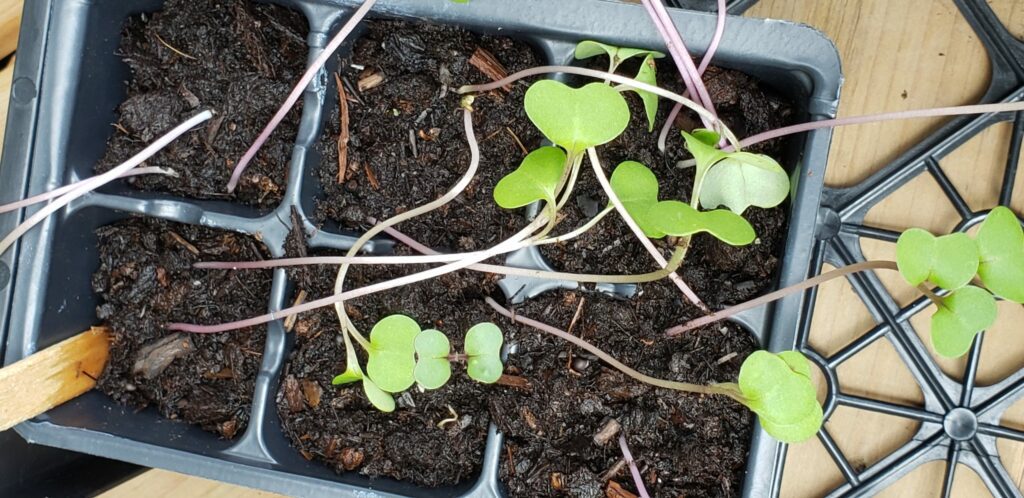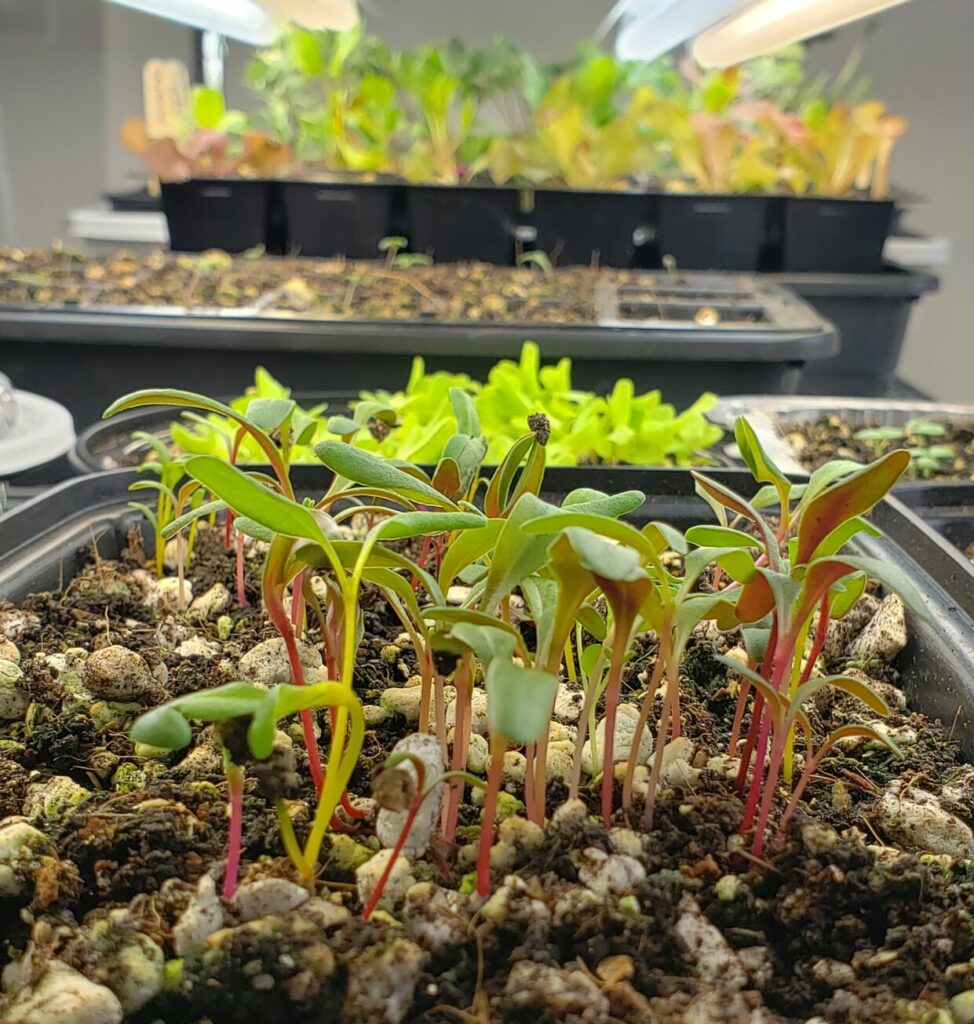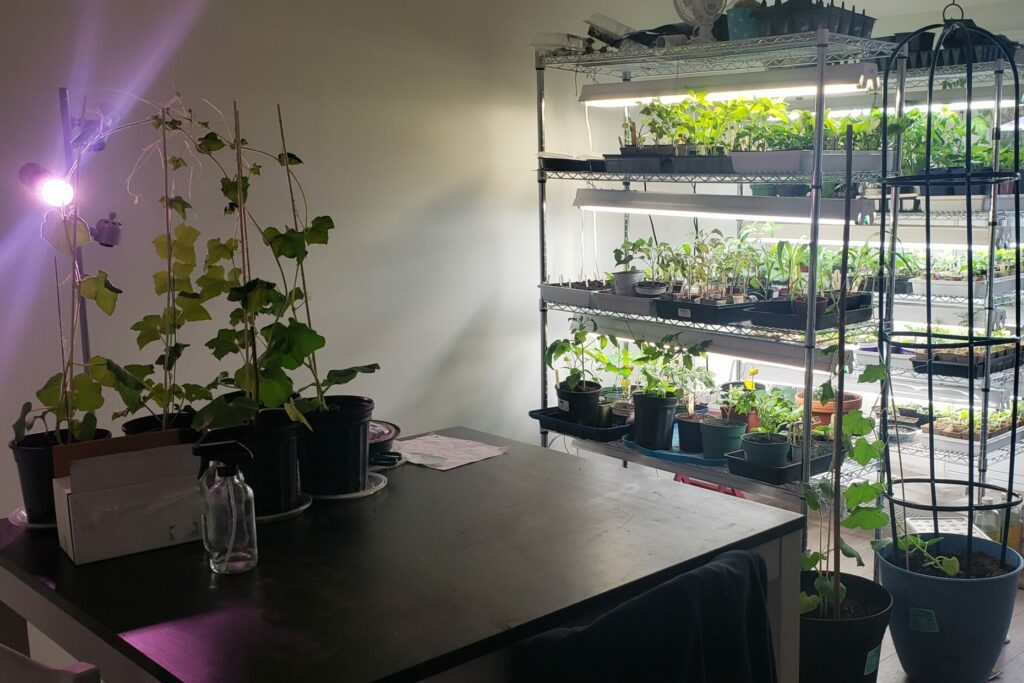Starting from seed is such a great way to learn about plants, expand the variety you grow in your garden, and to get your hands dirty earlier in the season.
When growing from seed, there are common issues that all gardeners experience. It can be scary learning and making mistakes, so we want to support you by providing you with the 8 most common mistakes that growers make when starting from seed.
Mistakes at a Glance
Using old soil to start your seeds
Seeds are very particular on the type of soil they want to grow in. Using old soil can cause issues with the seeds as they can carry bacteria, pathogens or be deficient in nutrients. Pathogens can lead to ‘damping off’ which is when the seedlings die overnight, as if they completely wilted and dried out. If there are nutrient deficiencies in the soil it can stunt the plants and they won’t grow and it will be extremely difficult to get them to recover. The photo below is of a swiss chard seedling that stunted due to deficient soil. This plant should have been 3 times the size it was for the age it was.
You can buy seed starting soil from most greenhouses and garden centres, however if you wish to create your own seed starting soil, check out our peat-free seed starting recipe here.

Sowing your seeds too deep (or too shallow)
It is important to know the depth to plant seeds, because if you plant them too deep they won’t have enough energy stored in the seed to be able to reach the surface. Also, some seeds need light to germinate, so if you plant them too deep they won’t get the light they need to grow.
Additionally, if you plant them too shallow, it can cause issues with the roots finding their way down the soil and it can make them grow in awkward ways. Similar to seeds that require light to germinate, some seeds require complete darkness to germinate. If you plant the seeds too shallow, they may not get the darkness they need to grow.
Consulting with the seed packet instructions is the best way to know how deep to plant the seeds. If you are unsure how to successfully read a seed packet, check out our guide here.
Watering the seeds too much (or too little)
It is important to ensure the seeds get watered just the right amount. We have the issue of not watering our seeds enough, however many people tend to water too frequently thinking it’s better to have more water than less. If you water from the bottom it is a great way to ensure you aren’t overwatering. Pour water in the bottom tray with your seeds and let it sit for 30 minutes. Discard any excess water. Once the soil appears dry you can repeat the process. If you over water, there is a chance the seed will mould or spoil from the excess water.
The opposite issue is allowing the soil to get too dry from too little watering. Seeds need to constantly be moist to aid in germination. Seed soil has really good drainage so it dries out quickly. Especially when growing indoors in the winter, the lack of humidity in the house will help the soil dry out fast. Seed sprouts are very small and don’t hold much moisture, so if the soil dries out, it does not take long for the plants to die. If this occurs, water the soil and wait 24 hours. Some of the seedlings might bounce back.
Not having a heat mat/turning the heat mat off too early (or too late)
Heat mats are a really affordable tool for seed starting. You can get a heat mat for around $25 which is super affordable because they will last you many years. Certain plants germinate faster and more successfully with heat, such as tomatoes, eggplants and peppers. By using one it helps with germination rate and timing.
The next issue is turning the heat mat off too early. The general rule of thumb is to not turn it off until over 75% of the seeds have germinated. Once you plug it in, you keep the mat on 24/7 until the seeds germinate. If you turn it off too early it can stop the other seeds from germinating because they rely on the heat.
Finally, leaving the heat mat on after the seeds have germinated can cause fungal disease in the soil, or weaken the plants.
Sign up to our newsletter to get gardening advice directly to your inbox
Leaving the humidity dome on too long
Although having a clear dome on your seed starts is a great tool, it is not necessary. Having a dome over your seeds helps keep moisture, heat and humidity in which helps with germination. The common mistake here is not whether you use a dome or not, but rather leaving it on too long when you do use it. Once 60% or more of the seeds have sprouted, you can start determining if you want to take the dome off. Because the dome increases moisture and humidity, it can also be a perfect environment for pathogens in the soil. Also, the light does not reach the plants as well as it would without the dome on.
Having the dome on can increase the risk of disease with your plants, and can also make them leggy as they stretch for the light. Leggy seedlings are not as strong as those that are not fighting for light. Therefore, watching the germination of your seeds and removing the dome at the correct time is important.
Not having the grow lights close enough to the plants
New plants need a lot of light. The sun outside is significantly stronger than grow lights, so this is not an issue when growing outdoors. However, due to the weakness of the indoor lights, plants need to be very close in order to get the right strength. Lights should be within one to two inches of the top of the plant to grow strong. If the lights are further away this can cause the seedlings to be leggy and stretch looking for light. Leggy seedlings are much weaker than their counterparts who have light close to the leaves. See the picture below for an example of leggy seedlings.
If you don’t use grow lights and grow on a window sill, often times you will notice your plants are growing crooked as they reach for the window and the sun. They will also be much taller than plants grown under lights as they stretch for the sun. This is due to low light levels.
We have a seed starting equipment guide available here if you are looking to start or change your seed starting setup.

Not thinning plants before they grow too big
Some seeds are easier to sow in a group, or come in compound seeds (more than one plant per seed ball). Plants that have either compound seeds or tend to be sown in groups include: beets, radish, carrots, and swiss chard. One of the most difficult tasks is thinning seeds because we never want to kill plants that we have grown. However, if you do not thin seedlings than they won’t grow to full size and you will end up with small or weak plants. Greed always gets the best of us, and we pay for it later in the season.
If you do not want to prick out and kill plants, you can always separate them. If you choose to separate the seedlings, you will want to do it once they get their first or second set of leaves, no later, so that the root system isn’t too large that it makes it impossible to separate the plants.

Starting seeds too early
We saved the biggest for last. We get it, growing from seed is extremely exciting. However, starting your seeds too early causes so many issues down the road. First, you have to pot up the plants way more times than necessary, which translates to time spent, money spent (on soil), owning tons of pots and needing a lot of extra space. Second, if your plants get too large and you procrastinate from potting them up (again), it can cause the plant to get stunted, which causes issues further into the season. Third, when large indoor seedlings get planted outside next to medium size ones that were planted later, it is shown that the smaller plants will catch up with the larger ones in a short period of time. Therefore, you don’t end up ahead of the game when it comes to growth, however you have put in a lot of extra work in the weeks leading up to planting out.
Pictured below are luffas that I started way too early, and I was left trying to find a way to support them indoors until it was time to plant them out. It was really stressful!

Now that you know this..
Be prepared to make all of these mistakes yourself! There’s a reason why these are common mistakes. Even after years of growing from seed you will likely make at least one of these mistakes every year. It’s so simple to make a mistake when growing from seed because everything happens so quickly in the seed world, and our time is limited. Your soil will dry out faster than you realize, your seeds will sprout overnight and you’ll be too busy to turn off the heat mat or take off the dome. Spring will come and you will see friends in warmer zones starting their seeds and you will get over excited and start yours too. But that’s okay!
Gardening is a never ending experiment. Plants are (generally) very forgiving. And if you make a massive mistake and they all die? The greenhouse has endless plants for you to buy! Don’t put too much pressure on yourself and just have fun.
As you continue on your seed growing journey we have more guides that you will find helpful:
- How to Read a Seed Packet
- 8 Easy to Grow Seeds for the Beginner Gardener
- Avoid these 8 Mistakes When Starting from Seed
- What You Need to Grow Your Own Seeds Indoors
- How to Make Peat-Free Seed Starting Soil









